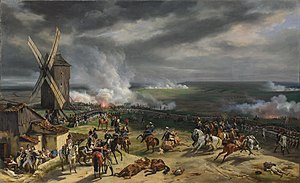User:Horseman1848/sandbox
The French Revolutionary Wars were a series of sweeping military conflicts lasting from 1792 until 1802 and resulting from the
As early as 1791, the other monarchies of Europe looked with outrage at the revolution and its upheavals; and they considered whether they should intervene, either in support of King
In 1794, the situation improved dramatically for the French as huge victories at
The War of the Second Coalition began in 1798 with the French invasion of Egypt, headed by Napoleon. The Allies took the opportunity presented by the French effort in the Middle East to regain territories lost from the First Coalition. The war began well for the Allies in Europe, where they gradually pushed the French out of Italy and invaded Switzerland—racking up victories at Magnano, Cassano and Novi along the way. However, their efforts largely unraveled with the French victory at Zurich in September 1799, which caused Russia to drop out of the war.[4] Meanwhile, Napoleon's forces annihilated a series of Egyptian and Ottoman armies at the battles of the Pyramids, Mount Tabor and Abukir. These victories and the conquest of Egypt further enhanced Napoleon's popularity back in France and he returned in triumph in the fall of 1799. However, the Royal Navy had won the Battle of the Nile in 1798, further strengthening British control of the Mediterranean.
Napoleon's arrival from Egypt led to the fall of the
War of the First Coalition
This section needs additional citations for verification. (April 2018) |
1791–1792
The key figure in initial foreign reaction to the revolution was
France eventually issued an ultimatum demanding that the

While the revolutionary government frantically raised fresh troops and reorganized its armies, a mostly Prussian Allied army under
On 10 August,
Meanwhile, the French had been successful on several other fronts, occupying Savoy and Nice, which were parts of the Kingdom of Sardinia, while General Custine invaded Germany, occupying several German towns along the Rhine and reaching as far as Frankfurt. Dumouriez went on the offensive in the Austrian Netherlands once again, winning a great victory over the Austrians at the Battle of Jemappes on 6 November and occupying the entire country by the beginning of winter.[9]
1793
Spain and Portugal entered the anti-French coalition in January 1793. Britain began military preparations in late 1792 and declared that war was inevitable unless France gave up its conquests, notwithstanding French assurances they would not attack Holland or annex the Low Countries.[10] Britain expelled the French ambassador following the execution of Louis XVI and on 1 February France responded by declaring war on Great Britain and the Dutch Republic.[5]
France drafted hundreds of thousands of men, beginning a policy of using mass conscription to deploy more of its manpower than the autocratic states could manage to do (first stage, with a decree of 24 February 1793 ordering the draft of 300,000 men, followed by the general mobilization of all the young men able to be drafted, through the famous decree of 23 August 1793). Nonetheless, the Coalition allies launched a determined drive to invade France during the Flanders Campaign.[11]
France suffered severe reverses at first. They were driven out of the
By the end of the year, large new armies had turned back foreign invaders, and the Reign of Terror, a fierce policy of repression, had suppressed internal revolts. The French military was in the ascendant. Lazare Carnot, a scientist and prominent member of the Committee of Public Safety, organized the fourteen armies of the Republic, and was then nicknamed the Organizer of the Victory.[13]
1794
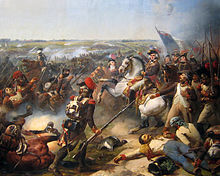
The year 1794 brought increased success to the French armies. On the
On the northern front in the
On the middle Rhine front in July, General Michaud's Army of the Rhine attempted two offensives in July in the Vosges, the second of which was successful but not followed up, allowing for a Prussian counter-attack in September. Otherwise this sector of the front was largely quiet over the course of the year.
At sea, the French Atlantic Fleet succeeded in holding off a British attempt to interdict a vital cereal
.By the end of the year French armies had won victories on all fronts, and as the year closed they began advancing into the Netherlands.
1795

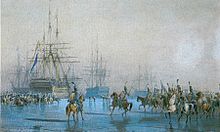
The year opened with French forces in the process of attacking the Dutch Republic in the middle of winter. The Dutch people rallied to the French call and started the Batavian Revolution. City after city was occupied by the French. The Dutch fleet was captured, and the stadtholder William V fled to be replaced by a popular Batavian Republic, a sister republic which supported the revolutionary cause and signed a treaty with the French, ceding the territories of North Brabant and Maastricht to France on 16 May.
With the Netherlands falling, Prussia also decided to leave the coalition, signing the Peace of Basel on 6 April, ceding the west bank of the Rhine to France. This freed Prussia to finish the occupation of Poland.
The French army in Spain advanced in
Meanwhile,
On the Rhine frontier, General
In northern Italy, victory at the Battle of Loano in November gave France access to the Italian peninsula.
1796
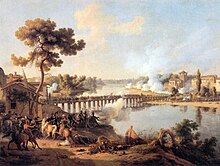
The French prepared a great advance on three fronts, with Jourdan and
Napoleon, on the other hand, was completely successful in a daring invasion of Italy. He left Paris on 11 March for Nice to take over the weak and poorly supplied Army of Italy, arriving on 26 March. The army was already being reorganised and supplied when he arrived, and he found that the situation was rapidly improving. He was soon able to carry out the plan for the invasion of Italy that he had been advocating for years, which provided for an advance over the Apennines near Altare to attack the enemy position of Ceva.
The
After a short pause, Napoleon carried out a brilliant flanking manoeuvre, and crossed the
During July and August, Austria sent a fresh army into Italy under
In September, Bonaparte marched north against Trento in Tyrol, but Wurmser had already marched toward Mantua by the Brenta valley, leaving Paul Davidovich's force to hold off the French. Bonaparte overran the holding force at the Battle of Rovereto. Then he followed Wurmser down the Brenta valley, to fall upon and defeat the Austrians at the Battle of Bassano on 8 September. Wurmser elected to march for Mantua with a large portion of his surviving troops. The Austrians evaded Bonaparte's attempts to intercept them but were driven into the city after a pitched battle on 15 September. This left nearly 30,000 Austrians trapped in the fortress. This number rapidly diminished due to disease, combat losses, and hunger.
The Austrians sent yet another army under József Alvinczi against Bonaparte in November. Again the Austrians divided their effort, sending Davidovich's corps from the north while Alvinczi's main body attacked from the east. At first they proved victorious over the French at Bassano, Calliano, and Caldiero. But Bonaparte ultimately defeated Alvinczi in the Battle of Arcole southeast of Verona. The French then turned on Davidovich in great strength and chased him into the Tyrol. Wurmser's only sortie was late and ineffectual.
The
1797


On 14 February, British admiral
On 22 February French invasion force consisting of 1,400 troops from the
In Italy,
Although Britain remained at war with France, this effectively ended the
1798


With only Britain left to fight and not enough of a navy to fight a direct war, Napoleon conceived of an
Napoleon sailed from Toulon to Alexandria, taking Malta on the way, and landing in June. Marching to Cairo, he won a great victory at the Battle of the Pyramids; however, his fleet was sunk by Nelson at the Battle of the Nile, stranding him in Egypt. Napoleon spent the remainder of the year consolidating his position in Egypt.[15]
The French government also took advantage of internal strife in Switzerland to
An expeditionary force was sent to County Mayo, in Ireland, to assist in the rebellion against Britain in the summer of 1798. It had some success against British forces, most notably at Castlebar, but was ultimately routed while trying to reach Dublin. French ships sent to assist them were captured by the Royal Navy off County Donegal.
The French were also under pressure in the Southern Netherlands and Luxembourg where the local people revolted against conscription and anti-religious violence (Peasants' War). The French had taken this territory in 1794, but it was officially theirs in 1797 due to a treaty with Austria. The French forces easily handed the Peasants' rebellion in the Southern Netherlands, and were able to put down the revolting forces in under 2 months.
The French in 1798 fought an undeclared war at sea against the United States, that was known variously as the "Quasi-War", the "Half War" and the "Pirate Wars". It was resolved peaceably with the Convention of 1800.
War of Second Coalition
Britain and Austria organized a new coalition against France in 1798, including for the first time the Russian Empire, although no action occurred until 1799 except against the kingdom of the Two Sicilies.
1799


In Egypt, Napoleon had consolidated his control of the country for the time being. Soon after the beginning of the year, he mounted an invasion of Syria, capturing
In Europe, the French Army of Observation,
The major part of the imperial army, under command of the Archduke Charles', had wintered immediately east of the Lech, which Jourdan knew, because he had sent agents into Germany with instructions to identify the location and strength of his enemy. This was less than 64 kilometres (40 mi) distant; any passage over the Lech was facilitated by available bridges, both of permanent construction and temporary pontoons and a traverse through friendly territory.[19]
In March 1799, the Army of the Danube engaged in two major battles, both in the southwestern German theater. At the intensely fought Battle of Ostrach, 21–2 March 1799, the first battle of the War of the Second Coalition, Austrian forces, under the command of Archduke Charles, defeated Jourdan's Army of the Danube. The French suffered significant losses and were forced to retreat from the region, taking up new positions to the west at Messkirch (Mößkirch, Meßkirch), and then at Stockach and Engen. At the second battle, in Stockach, on 25 March 1799, the Austrian army achieved a decisive victory over the French forces, and again pushed the French army west. Jourdan instructed his generals to take up positions in the Black Forest, and he himself established a base at Hornberg. From there, General Jourdan relegated command of the army to his chief of staff, Jean Augustin Ernouf, and traveled to Paris to ask for more and better troops and, ultimately, to request a medical leave.[20]
The Army was reorganized, and a portion placed under the command of
Napoleon himself invaded Syria from Egypt, but after a failed
1800
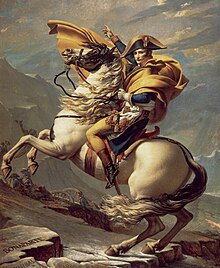
In Italy, the Austrians under General Melas attacked first, and by the third week in April had advanced to the Var, with Massena and half his army in Genoa besieged by land, by the Austrians and under tight blockade by the Royal Navy. In response Berthier moved – not to the threatened frontier, but to Geneva – and Massena was instructed to hold Genoa until 4 June. The Army of the Reserve was joined by Napoleon, and in mid-May set out to cross the Alps to attack the Austrian rear. The bulk of the army crossed by the Great St Bernard Pass, still under snow, and by 24 May 40,000 troops were in the valley of the Po. Artillery was man-hauled over with great effort and ingenuity; however an Austrian-held fort on the Italian side (although bypassed by infantry and cavalry) prevented most of the artillery reaching the plains of Northern Italy until the start of June.
Once over the Alps, Napoleon did not proceed directly to the relief of Genoa. Instead, he advanced on Milan, to improve his lines of communication (via the Simplon and St Gotthard passes) and to threaten Melas's lines of communication with Mantua and Vienna, in the belief that this would cause Melas to raise the siege of Genoa. He entered Milan on 2 June and by crossing to the South bank of the Po completely cut Melas's communications. Taking up a strong defensive position at Stradella, he confidently awaited an attempt by the Austrian Army to fight its way out.
However, Melas had not raised the siege of Genoa, and on 4 June, Masséna had duly capitulated. Napoleon then faced the possibility that, thanks to the British command of the Mediterranean, far from falling back, the Austrians could instead take Genoa as their new base and be supplied by sea. His defensive posture would not prevent this; he had to find and attack the Austrians before they could regroup. He therefore advanced from Stradella towards Alessandria, where Melas was, apparently doing nothing. Convinced that Melas was about to retreat, Napoleon sent strong detachments to block Melas's routes northwards to the Po, and southwards to Genoa. At this point, Melas attacked, and for all the brilliance of the previous campaign, Napoleon found himself at a significant disadvantage in the consequent Battle of Marengo (14 June). Napoleon and the French came under huge pressure in the early hours of the battle. Melas believed he had already won and turned over delivery of the final blow to a subordinate. Suddenly, the prompt return of a detached French force under Desaix and a vigorous French counter-attack converted the battle into a decisive French victory. The Austrians lost half of their army, but Desaix was one of the French victims.
Melas promptly entered into negotiations, which led to the Austrians evacuating Northern Italy west of the Ticino and suspending military operations in Italy. Napoleon returned to Paris after the victory, leaving Brune to consolidate in Italy and begin a march toward Austria.
In the German theater, the armies of France and Austria faced each other across the Rhine at the beginning of 1800.

On 4 and 5 May, the French launched repeated and fruitless assaults on the Messkirch. At nearby Krumbach, where the Austrians also had the superiority of position and force, the 1st Demi-Brigade took the village and the heights around it, which gave them a commanding aspect over Messkirch. Subsequently, Kray withdrew his forces to Sigmaringen, followed closely by the French. Fighting at nearby Biberach an der Ris ensued on 9 May; action principally consisted of the 25,000 man-strong French "Center", commanded by Laurent de Gouvion Saint-Cyr.[26] After being flanked by General Moreau, who approached Ulm from the east and overwhelmed his outposts at Battle of Höchstädt, Kray retreated to Munich. Again, on 10 May, the Austrians withdrew with heavy losses, this time to Ulm.[27]
A several month armistice followed, during which Kray was replaced by the Archduke John, with the Austrian army retiring behind the river Inn. Austrian reluctance to accept negotiated terms caused the French to end the armistice in mid-November, effective in two weeks. When the armistice ended, John advanced over the Inn towards Munich. His army was defeated in small engagements at the battles of Ampfing and Neuburg an der Donau, and decisively in the forests before the city at Hohenlinden on 3 December. Moreau began a march on Vienna, and the Austrians soon sued for peace, ending the war on the continent.
1801

By 9 February, the Austrians had signed the
The naval war also continued, with the United Kingdom maintaining a blockade of France by sea. Non-combatants Russia,
1802
In 1802, the British and French signed the
Influence

The French Revolution transformed nearly all aspects of French and European life. The powerful sociopolitical forces unleashed by a people seeking liberté, égalité, and fraternité made certain that even warfare was not spared this upheaval. 18th-century armies—with their rigid protocols, static operational strategy, unenthusiastic soldiers, and aristocratic officer classes—underwent massive remodeling as the French monarchy and nobility gave way to liberal assemblies obsessed with external threats. The fundamental shifts in warfare that occurred during the period have prompted scholars to identify the era as the beginning of "modern war".[28]
In 1791 the Legislative Assembly passed the "Drill-Book" legislation, implementing a series of infantry doctrines created by French theorists because of their defeat by the Prussians in the Seven Years' War.[29] The new developments hoped to exploit the intrinsic bravery of the French soldier, made even more powerful by the explosive nationalist forces of the Revolution. The changes also placed a faith on the ordinary soldier that would be completely unacceptable in earlier times; French troops were expected to harass the enemy and remain loyal enough to not desert, a benefit other Ancien Régime armies did not have.
Following the declaration of war in 1792, an imposing array of enemies converging on French borders prompted the government in Paris to adopt radical measures. 23 August 1793, would become a historic day in military history; on that date the National Convention called a levée en masse, or mass conscription, for the first time in human history. By summer of the following year, conscription made some 500,000 men available for service and the French began to deal blows to their European enemies.[30]
Armies during the Revolution became noticeably larger than their Holy Roman counterparts, and combined with the new enthusiasm of the troops, the tactical and strategic opportunities became profound. By 1797 the French had defeated the
In addition to opening a flood of tactical and strategic opportunities, the Revolutionary Wars also laid the foundation for modern military theory. Later authors that wrote about "nations in arms" drew inspiration from the French Revolution, in which dire circumstances seemingly mobilized the entire French nation for war and incorporated nationalism into the fabric of military history.[31] Although the reality of war in the France of 1795 would be different from that in the France of 1915, conceptions and mentalities of war evolved significantly. Clausewitz correctly analyzed the Revolutionary and Napoleonic eras to give posterity a thorough and complete theory of war that emphasized struggles between nations occurring everywhere, from the battlefield to the legislative assemblies, and to the very way that people think.[32] War now emerged as a vast panorama of physical and psychological forces heading for victory or defeat.
See also
- Military career of Napoleon Bonaparte
- Napoleonic Wars
Footnotes
Notes
- Habsburg ruled states such as the Grand Duchy of Tuscany, had close ties with the Habsburgs.
- ^ a b Neutral following the Treaty of Basel in 1795.
- ^ a b Became the United Kingdom of Great Britain and Ireland on 1 January 1801.
- ^ French invasion of Switzerland
- Napoleon's invasion in 1796 and became French satellite states.
- ^ Most forces fled rather than engaging the invading French army. Allied with France in 1795 as the Batavian Republic following the Peace of Basel.
- ^ War against Austria was actually announced in the National Assembly by then King Louis XVI of the French on 20 April 1792 while the kingdom still existed in name. (Constitutional) monarchy was suspended on 10 August following the assault on the Tuileries, and abolished 21 September 1792
- ^ Started the Irish Rebellion of 1798 against British rule.
- ^ Arrived in France following the abolition of the Polish–Lithuanian Commonwealth after the Third Partition in 1795.
- ^ Re-entered the war as an ally of France after signing the Second Treaty of San Ildefonso.
- ^ Officially neutral but Danish fleet was attacked by Great Britain at the Battle of Copenhagen.
References
- ^ a b c d e f g h i Clodfelter 2017, p. 100.
- ^ a b Clodfelter 2017, p. 103.
- ^ TCW Blanning, The French Revolutionary Wars. pp. 78–79.
- ^ TCW Blanning, The French Revolutionary Wars. pp. 254–55.
- ^ a b Georges Lefebvre, The French Revolution Volume II: from 1793 to 1799 (1964) ch. 1.
- ^ Lecky, William Edward Hartpole, A History of England in the Eighteenth Century Volume V (1890) p. 601
- ISBN 9780203209745.
- ^ William Doyle, The Oxford History of the French Revolution (1989) p. 194
- ISBN 9780521466844.
- ^ Lecky, William Edward Hartpole, A History of England in the Eighteenth Century Volume VI (1890) pp. 101–30
- ^ Alan Forrest, Soldiers of the French Revolution (1989)
- ^ Robert Forczyk, Toulon 1793: Napoleon's First Great Victory (2005)
- ^ Paddy Griffith, The Art of War of Revolutionary France, 1789–1802 (1998)
- ISBN 1-85715-121-6
- ^ Paul Strathern, Napoleon in Egypt: The Greatest Glory (2007)
- ^ Jourdan, p. 140.
- ^ Masséna, commanding the Army of Switzerland, sent a Demi-brigade to secure the Swiss town of Schaffhausen, on the north shore of the Rhine, which guaranteed communications between the two forces. Jourdan, pp. 96–97.
- ^ Jourdan, p. 97.
- ^ Rothenberg, pp. 70–74; Jourdan, pp. 65–88; 96–100; Blanning, p. 232; (in German) Ruth Broda. "Schlacht von Ostrach:“ jährt sich zum 210. Mal – Feier am Wochenende. Wie ein Dorf zum Kriegsschauplatz wurde. In: Südkurier vom 13. Mai 2009.
- ^ a b Young, pp. 230–345; Gallagher, p. 70–79; Jourdan, pp. 190–204.
- ^ Georges Lefebvre, The French Revolution Volume II: from 1793 to 1799 (1964) ch 13
- ^ Arnold, 197–199.
- ^ Arnold, 199–201
- ^ W.M. Sloane, Life of Napoleon. France, 1896, p. 109.
- ^ Sloane, 109.
- ^ Sloane, pp. 109–10.
- ^ Digby Smith, Napoleonic Wars Databook. London: Greenhill Press, 1998, p. 178.
- ^ Lester Kurtz and Jennifer Turpin, Encyclopedia of violence, peace and conflict, Volume 2. p. 425
- ^ David G. Chandler, The Campaigns of Napoleon. p. 136
- ^ T. C. W. Blanning, The French Revolutionary Wars. p. 109
- ^ Parker, Geoffrey. The Cambridge history of warfare. p. 189
- ^ Peter Paret, Clausewitz and the State. p. 332
Further reading
- Clodfelter, M. (2017). Warfare and Armed Conflicts: A Statistical Encyclopedia of Casualty and Other Figures, 1492-2015 (4th ed.). Jefferson, North Carolina: McFarland. ISBN 978-0786474707.
- Atkinson, Charles Francis; Hannay, David McDowall (1911). . In Chisholm, Hugh (ed.). Encyclopædia Britannica. Vol. 11 (11th ed.). Cambridge University Press. pp. 171–205.
- Bertaud, Jean-Paul. The Army of the French Revolution: From Citizen-Soldiers to Instrument of Power (1988), a major French study
- Black, Jeremy. British Foreign Policy in an Age of Revolutions, 1783–93 (1994)
- Blanning, T. C. W. The French Revolutionary Wars, 1787–1801. (1996) excerpt and text search
- Bryant, Arthur. Years of Endurance 1793–1802 (1942); on Britain
- Connelly, Owen. The wars of the French Revolution and Napoleon, 1792–1815 (2006)
- Crawley, C. W., ed. The New Cambridge Modern History, Vol. 9: War and Peace in an Age of Upheaval, 1793–1830 (1965), comprehensive global coverage by experts
- Doughty, Robert, and Ira Gruber, eds. Warfare in the Western World: volume 1: Military operations from 1600 to 1871 (1996) pp. 173–94
- Dupuy, Trevor N. and Dupuy, R. Ernest. The Harper Encyclopedia of Military History (2nd ed. 1970) pp. 678–93
- Esdaile, Charles. The French Wars 1792–1815 (2002) 113pp excerpt and text search, ch 1
- Forrest, Alan. Soldiers of the French Revolution (1989)
- Forrest, Alan. "French Revolutionary Wars (1792–1802)" in Gordon Martel, ed. The Encyclopedia of War (2012).
- Fremont-Barnes, Gregory. The French Revolutionary Wars (Essential Histories) (2013) excerpt and text search
- Gardiner, Robert. Fleet Battle And Blockade: The French Revolutionary War 1793–1797 (2006), naval excerpt and text search
- Griffith, Paddy. The Art of War of Revolutionary France, 1789–1802 (1998) excerpt and text search; military topics, but not a battle history
- Knight, Roger. Britain Against Napoleon: The Organisation of Victory, 1793–1815 (2013)
- Lavery, Brian. Nelson's Navy, Revised and Updated: The Ships, Men, and Organization, 1793–1815 (2nd ed. 2012)
- Lefebvre, Georges. The French Revolution Volume II: from 1793 to 1799 (1964).
- Lynn, John A. The Bayonets of the Republic: Motivation And Tactics In The Army Of Revolutionary France, 1791–94 (1984)
- Roberts, Andrew. Napoleon (2014), a major biography
- Rodger, A.B. The War of the Second Coalition: 1798 to 1801, a strategic commentary (1964)
- Ross, Steven T. Quest for Victory; French Military Strategy, 1792–1799 (1973)
- Ross, Steven T. European Diplomatic History, 1789–1815: France Against Europe (1969)
- Rothenberg, Gunther E. (1982). Napoleon's Great Adversaries: The Archduke Charles and the Austrian Army 1792–1814.
- Rothenberg, Gunther E. "The Origins, Causes, and Extension of the Wars of the French Revolution and Napoleon," Journal of Interdisciplinary History (1988) 18#4 pp. 771–93 in JSTOR
- Schroeder, Paul W. The Transformation of European Politics 1763–1848 (Oxford University Press, 1996); advanced diplomatic history; pp. 100–230 online
- Schneid, Frederick C.: The French Revolutionary and Napoleonic Wars, Institute of European History, 2011. Retrieved 29 June 2011.
- von Guttner, Darius. The French Revolution [1] (2015).
Historiography
- Simms, Brendan. "Britain and Napoleon," Historical Journal (1998) 41#3 pp. 885–94 in JSTOR
In French
- Attar, Frank, La Révolution française déclare la guerre à l'Europe. ISBN 2-87027-448-3
- Attar, Frank, • Aux armes citoyens ! Naissance et fonctions du bellicisme révolutionnaire. ISBN 2-0208-8891-2


